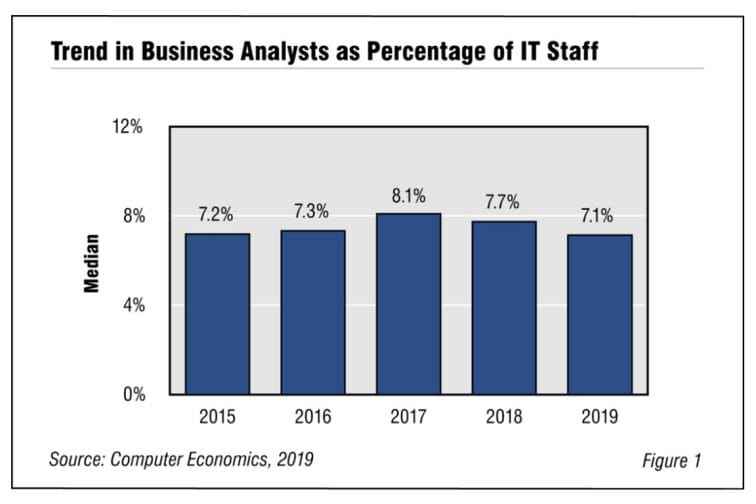With digital transformation taking center stage in recent years, we have predicted that the business analyst role would continue to rise in prominence within IT organizations. However, the number of business analysts as a percentage of the total IT staff has dropped for the second straight year. We still believe that business analyst role is becoming more important. But the center of gravity for business analysts is increasingly moving out of the IT organization.
As shown in Figure 1 from our full report, Business Analyst Staffing Ratios, business analysts as a percentage of the IT staff has dropped to 7.1% of the IT staff at the median, which is a five-year low.

We have often noted that the IT staffing mix is changing as the move to the cloud continues in earnest, and the IT organization should play a leading role in the digital transformation of the business. As such, the need for IT personnel who understand and interact with the business continues to rise. Business analysts, after all, are at the forefront of the relationship between IT and the rest of the business.
So why hasn’t the role of business analyst grown? We were not wrong about the digital transformation. We were not wrong about the need for more professionals who understand the relationship between IT and the business. What has changed?
We believe that the primary factor is that many business analysts no longer reside in the IT department. As organizations implement major cloud systems and end-user organizations take more direct responsibility for them, the business analyst role may be naturally migrating to the business units served by those cloud applications.
For example, if an organization replaces an on-premises human capital management (HCM) system with a cloud system, it is common for the internal support for that system to move to the HR department. Except for data integration, there is really not much support required from the IT organization. It is natural, then, for the business analyst function—serving as a bridge to end-users of the system—to reside in the HR group as well. The same could be said for CRM systems and supply chain management systems. As true multi-tenant cloud systems make up a larger percentage of the organization’s application portfolio, the number of business analysts may actually increase, but they may increasingly be residing in line-of-business organizations.
“Another reason may be in play here as well,” said Tom Dunlap, director of research for Computer Economics, based in Irvine, Calif. “Which is that there may be a shortage of qualified candidates to fill open business analyst positions. The requisite combination of qualifications—technical knowledge, business perspective, and interpersonal skills—is difficult to find in a single individual. Add industry-specific experience and the job specification becomes even more demanding.”
In our report, we use a broad definition of business analysts. Typical roles include:
-
- Business analysts, who gather user requirements, define business processes, and help design, document, and deploy solutions using information systems.
- Any staff member who, regardless of title, serves as a primary liaison between users and IT, represents the user community to the IT group, and ensures that IT systems are used effectively by the organization.
The factors mentioned above make the question of how many business analysts an organization needs an even more difficult one, as the practice of using business analysts varies widely and is going through some major changes. In our full report, we assess typical staffing levels using four metrics: business analysts as a percentage of the IT staff, business analysts as a percentage of the Application Group, applications per business analyst, and users per business analyst. We also assess differences by organization size and sector.
This Research Byte is a brief overview of our report on this subject, Business Analyst Staffing Ratios. The full report is available at no charge for Avasant Research subscribers, or it may be purchased by non-subscribers directly from our website (click for pricing).

